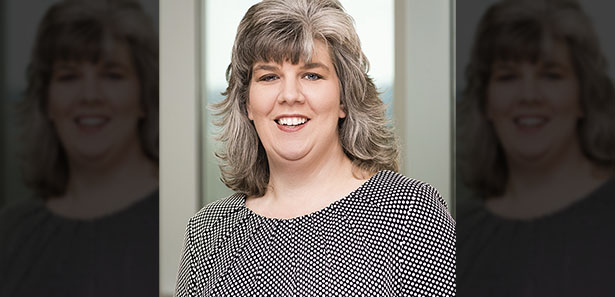Ballad Health’s Jamie Swift has the not-terribly-surprising roadmap through COVID for your business
by Scott Robertson
For most Americans, the idea of a pandemic striking during our lifetime seemed only a remote possibility before the COVID crisis. Not so for Jamie Swift, who started her career as a communicable disease nurse and served as director of Communicable and Environmental Disease Services with the Tennessee Department of Health for nine years before working her way up through the Mountain States Health Alliance and Ballad Health corporate system to become chief infection prevention officer and assistant vice president, Infection Prevention this summer. In fact, Swift says, “I have firmly believed I would live through a pandemic. I knew it was a very real possibility in my career.”
Having worked through the smallpox scare and H1N1, Swift says, “I have literally trained my entire career for this.”
Still, there are two things about the COVID crisis that have come as a surprise to Swift, she says. “I think just how infectious this disease is – it’s certainly more infectious than flu – and while things like Ebola scare people, we know that while Ebola is certainly highly infectious, it’s much harder to transmit just because you have to have direct exposure. With COVID being a respiratory disease, people are able to spread it before they know they are sick. That brings a whole new challenge. People are living their lives, going about their normal routine, and they are spreading the disease but don’t know it. That makes it really hard to fight.”
And second, “My whole time in public health, we were constantly training for the next emerging disease,” Swift says. “We just never trained for the resistance to the science and the confusion and misinformation. That’s not something I was really prepared for.”
Rounding the corner in the wrong direction
The COVID numbers are the worst they’ve been in the region Ballad Health serves, Swift says, and the trend isn’t backing off. “We’re really in widespread community spread of COVID-19,” she says. “You know, people continue to ask me, ‘Well, where is it coming from?’ and, ‘Is it clusters?’ and ‘Is it this source or that?’ We’re past the point of those questions. We are at the point in our community that if you go out, you’re at risk of contracting COVID-19 if you’re not taking the proper precautions. It’s truly widespread at this point. We’re past the point of contract tracing and identifying large clusters…it’s truly widespread.”
What makes the matter even worse is the impending arrival of flu season, which generally starts slow in the region around October, but gradually sees a significant rise of cases in early winter. “We are concerned (as we head into flu season),” Swift says. “We were hoping we could get our baseline COVID down right before we headed into flu season. Unfortunately, we are certainly higher than we have been. So, when you take that volume compared with the volume that we typically see during flu season, it is extremely concerning. We certainly have admissions from COVID come in through the emergency department (ED), and we see a lot of flu patients in the ED. So, we’re preparing to meet the needs in our communities so we can take care of all the other emergencies like traumas and heart attacks.”
The biggest problem this year may not even be the direct effect of the influenza virus, but rather the strain put on the healthcare delivery system by both COVID and the flu hitting at once. “You know, there’s not an unlimited number of resources in health care. I think you’re starting to see that. Cutting back on elective surgeries is certainly not anything any of us in the room wanted to do. But, right now we have got to be able to provide care to our region through the pandemic.”
Healthcare professionals are doing everything they can to ask the population to help bring the COVID numbers down before the flu season gets into full swing. But, Swift says, it is going to take the entire community. “A key piece of that is everybody getting vaccinated for the flu this year. If you have never been vaccinated, this is the year. I am literally begging you to go get a flu shot.”
“We know that in the best years, that shot is 60-70 percent effective,” Swift says. “But even in those years when it’s not a great match, we know that if you get the flu vaccine and still get the flu, you are less likely to be admitted and less likely to have serious outcomes including death. So that flu shot, even if you get a mild case of the flu, will probably be what’s going to keep you out of the hospital, and that’s what we need this year more than anything.”
What’s next – a vaccine? Herd immunity?
Of course, most everyone is praying for a vaccine, and Swift says Ballad Health is trying to be proactive in preparing for its eventual arrival. “I am anxious to see that vaccine come forward,” Swift says. “Within Ballad we have two different committees that are already working on vaccine planning because we know that it’s going to be a huge key to this pandemic response. There are various updates floating around as to when it will be available. But what I have done is really study and learn about the process that the vaccine is going through, about Operation Warp Speed and what that means.
“I am very comfortable with the process,” Swift says in response to questions about whether the vaccine will be greeted with the same skepticism some have shown toward preventative measures. “I don’t feel like corners are being cut,” she says. “I do feel like when it comes to market, it is going to be a safe vaccine. So, we’re continuing to follow that research. We want to make sure that we understand when that vaccine comes to market we can say, ‘okay, we’ve read all the documents. We understand the process and yes, we’re good.’ But then we also have to have that plan of how we distribute that vaccine within our health system. So, even though we don’t know when we’re going to have it, we are well into making plans for how we get that vaccine out to our team members as quickly as we can once we do get it.”
As for calls from some quarters for a nationwide attempt to create herd immunity, Swift is dismissive. “I don’t think it will come to that. I mean, we have never reached herd immunity with any disease without a vaccine. So, I just don’t think that’s realistic.”
What’s a business owner to do?
So, let’s say you’re a business owner or operator who’s been doing all the right things, following state and CDC guidelines, installing plexiglass between customers and employees, making masks available and buying so much hand sanitizer you don’t know where to put it all. But you’re watching the numbers across the nation and across the region and you’re worried. Another shutdown is simply not an option for most businesspeople.
The answer, Swift says, is something you’ve heard many times already. “First and foremost is the mask wearing,” she begins. “We know it can be effective. I mean, we’ve always said masks will not prevent 100 percent of infections. We know that. But, they certainly help reduce the risk of infection. So, ensuring that your team members – your employees – are masked and wearing the mask appropriately are key. You know, masks need to be worn over the nose and mouth to be effective. It doesn’t do us a lot of good if an employee has a mask on, but it’s gaping down way below their nose and even sometimes down below their mouth.
“Most of our counties do still have a mask mandate,” Swift continues. “Just asking your customers to comply with that is the absolute best way to keep your employees safe at this point. And again, it goes back to the fact that the masks are source control. That’s why we wear them. So, you’re asking your employees to wear masks to protect your customers, and you’re asking your customers to wear masks to protect your employees.
“Social distancing is key,” Swift says. “Spreading out is important, (as is) limiting the number of people you allow in your business, especially small offices where there’s not a lot of room to spread out. You may want to put a cap on how many people can enter at one time. I’ve seen several businesses that are doing that. Also, having alcohol gel available for customers to use after they pay, I think is a huge plus. I always look for that. I carry my own, but it’s also nice when it’s readily available in public for people to use.”
But, one might say, we’ve been doing these things and it’s still getting worse. Isn’t there something else we can do? “I think people are constantly looking for a different answer, and it hasn’t changed,” Swift says. “This is the same pandemic that we’re in the middle of. We have very limited resources to fight this right now. What we do have are the masks and the social distancing. Until we get a vaccine there is no magic bullet. People just have to understand that. I don’t think there’s a new spin that I can put on the message to make it more palatable to people. This is just where we are in the pandemic.”
It may be true that your business is doing all it can, but until the vaccine arrives, you also have to encourage others not to overdramatize the pandemic, but to respect it. “I always told my friends and family, ‘you can live through this pandemic and you can do it safely,’” Swift says. “You know, I’m certainly not making unnecessary trips right now, but I do go to the grocery store. People have to learn that the way out of this pandemic is through it. We can’t pretend it’s not here. We can’t go about life with absolutely no precautions because when we do, that’s when the virus spreads. But, we can certainly get control of this virus. We can break this cycle of spread by doing the things we need to do – wearing a mask, social distancing, good hand-washing, limiting your outings and staying at home when you can – we can do this.
“That’s what it’s going to take,” Swift says, “everybody doing those things.”




